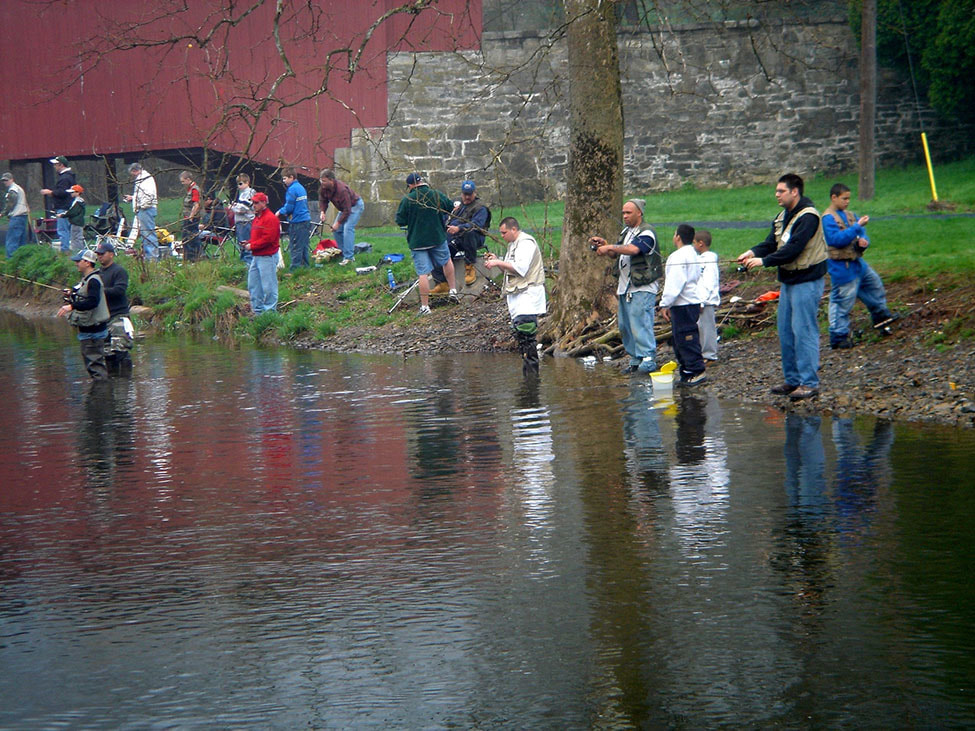 The Little Lehigh Creek is an extremely popular trout fishery that is being invaded by mudsnails. Photo by author The Little Lehigh Creek is an extremely popular trout fishery that is being invaded by mudsnails. Photo by author Our popular and most fished Little Lehigh Creek, has a problem according to this press release from the PA Fish & Boat Commission. It reads as follows: After confirming the presence of the aquatic invasive species (AIS) known as New Zealand Mudsnail (Potamopyrgus antipodarium) in Little Lehigh Creek, Lehigh County, the Pennsylvania Fish and Boat Commission (PFBC) is reminding anglers and boaters that cleaning their gear is the easiest, most effective means of preventing its spread to other waters. PFBC biologists collected Mudsnail specimens this month in Little Lehigh Creek west of Emmaus, PA near the Wildlands Conservancy. New Zealand Mudsnail expert Dr. Edward Levri of Penn State and PFBC Lead AIS Ecologist Bob Morgan confirmed the identity. New Zealand Mudsnails are very small, measuring less than one-quarter inch, with a relatively long, narrow, spiral shell that is generally brown to almost black in color. Like other aquatic invasive species, they disrupt ecosystems by rapidly multiplying and competing with native species for space and food. “Based on studies conducted in western U.S. streams, if the population grows quickly, they could become the dominant organisms in the benthic – or bottom dwelling – community, upon which many other species depend for food,” said Morgan, the PFBC’s ecologist who studies aquatic invasive species. “The first known occurrence of the New Zealand Mudsnail on the Atlantic slope of the Eastern U.S. was discovered about five years ago in Spring Creek, Centre County. Whether there is a connection with the infestation in Little Lehigh Creek is unknown at this time, but hopefully future genetic studies will give the answer. The effects of the snail in Atlantic slope streams on higher organisms, such as fish, are not certain at this time.” New Zealand Mudsnail has spread to Europe, Asia, Australia and North America. They were discovered in the Snake River in Idaho and Wyoming in 1987; in Lake Ontario and the St. Lawrence River in 1991; and in Lake Erie about 4 miles north of Presque Isle Bay in 2007. Additional populations were found in a small stream near the Niagara River in New York in 2008 and in another Lake Ontario tributary in 2011. New Zealand Mudsnails have recently been found in the Gunpowder River in Maryland and in the Musconetcong River in New Jersey (near Riegelsville, PA) which is a tributary of the Delaware River. “Spring Creek and Little Lehigh Creek have at least one thing in common – they are both heavily fished streams, with anglers travelling to them from all over,” added Morgan. “Given the presence of the Mudsnail in other areas of the country, it’s not surprising they have been found here. As with many aquatic invasive species, they are nearly impossible to eradicate once established. This is even more difficult with the Mudsnail because it usually takes only one small snail to be able to produce offspring. But we must do our best to slow its spread to other waters.” Anglers and boaters are urged to “Clean Your Gear!” before leaving a waterway and entering another one. New Zealand Mudsnails require some specialized disinfection measures. Gear should be visually inspected and any clinging matter should be removed and disposed of in the trash. To kill Mudsnails, three methods are effective. Gear can be frozen for a minimum of eight hours, or it can be soaked in very hot water with detergent - maintained at 120°F to 140°F - for ten minutes. This last method is not recommended for Goretex®. Also, a 2005 study by the California Department of Fish and Game showed that Mudsnails can be killed by soaking gear for five minutes in a one-to-one solution of a commercial product, Formula 409® Cleaner Degreaser Disinfectant, and water. After soaking gear for five minutes, thoroughly rinse it with plain water. Simply spraying gear with the disinfectant or the mixture does not work. Also, general cleaners such as regular off-the-shelf Formula 409 have not been shown to be effective against Mudsnail. If you suspect that you have found New Zealand Mudsnail (or any other AIS) in another waterway, please report your information at: http://pfbc.pa.gov/forms/reportAIS.htm . When reporting an AIS sighting it is very important to include as much information as possible including close-up photos of the organism, the exact location (GPS coordinates work best), a description of what you found, and your contact information. For more information about New Zealand Mudsnail, visit https://seagrant.psu.edu/section/fact-sheets-brochures and scroll down to the Mudsnail link.
0 Comments
Leave a Reply. |
AuthorNick Hromiak has been an outdoors and automotive writer for over 30 years. He's been published in numerous national and state-wide outdoor magazines and newspapers.
|
Proudly powered by Weebly
 RSS Feed
RSS Feed